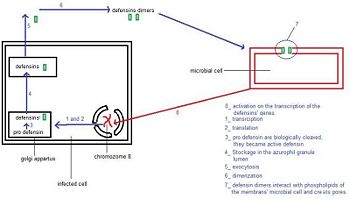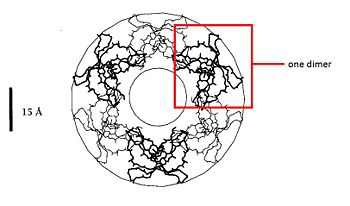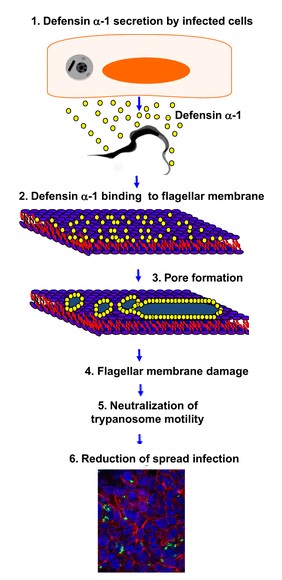Sandbox Reserved 959
From Proteopedia
(Difference between revisions)
| (3 intermediate revisions not shown.) | |||
| Line 8: | Line 8: | ||
== Introduction == | == Introduction == | ||
| - | Defensins (DEF) are a family of proteins which are involved in host defense in the epithelia of mucosal surfaces such as those of the intestin, respiratory tract, urinary tract, and vagina. They are antimicrobial and cytotoxic. All the | + | Defensins (DEF) are a family of proteins which are involved in host defense in the epithelia of mucosal surfaces such as those of the intestin, respiratory tract, urinary tract, and vagina. They are antimicrobial and cytotoxic. All the proteins of the family are distinguished by a cystein motif and are encoded on the chromozome 8.<ref>http://www.ncbi.nlm.nih.gov/gene/1667</ref><br /> There are many defensins but in this article we will focus on the '''defensin-α-1'''. It is a polypeptide which is found in the microbicidal granules of neutrophils. It is synthesized in the neutrophils, which plays a role in the defense process. defensin-α-1 plays a particular role in phagocite-mediated host defense.<ref>''Abraham L. Kierszenbaum. Histologie et biologie cellulaire: Une introduction à l'anatomie pathologique'' 2002</ref> |
| Line 16: | Line 16: | ||
== Biological role == | == Biological role == | ||
| - | The presence of an unknown microbial cell active the transcription of the defensin-α-1 gene in the human neutrophil. When the RNAm is translated defensins-α-1 are not active. They became active in the Golgi apparatus, in which they are biologically cleaved. Then they are | + | The presence of an unknown microbial cell active the transcription of the defensin-α-1 gene in the human neutrophil. When the RNAm is translated defensins-α-1 are not active. They became active in the Golgi apparatus, in which they are biologically cleaved. Then they are stored in the azurophil granule lumen. After the exocytosis, two defensins-α-1 create a dimere, which will attack the membran of the microbial cell, by the formation of channel. These channels destabilize the membrane, which causes the destruction of the unknown microbial cell. |
| - | This mecanism is | + | This mecanism is summed up in the following picture.<ref name="reactome">http://www.reactome.org/PathwayBrowser/#DIAGRAM=1461973&PATH=168256,168249</ref> |
| Line 23: | Line 23: | ||
|- | |- | ||
| | | | ||
| - | [[Image: schema1.jpg|350px|left|thumb| General pathway of defensins-α-1.<ref | + | [[Image: schema1.jpg|350px|left|thumb| General pathway of defensins-α-1.<ref name = "reactome"/>]] |
{{clear}} | {{clear}} | ||
|} | |} | ||
| Line 42: | Line 42: | ||
|- | |- | ||
| | | | ||
| - | [[Image: disulfure.jpg|350px|left|thumb| Defensin-Alpha-1 cysteine connectivities.<ref>Stephen H Wile, William C Wimley and Michael E Selsted. Structure, function, and membrane integration of defensins. Current Opinion in Structural Biology 1995. University of California, Irvine, USA</ref>]] | + | [[Image: disulfure.jpg|350px|left|thumb| Defensin-Alpha-1 cysteine connectivities.<ref name="stephen">Stephen H Wile, William C Wimley and Michael E Selsted. Structure, function, and membrane integration of defensins. Current Opinion in Structural Biology 1995. University of California, Irvine, USA</ref>]] |
{{clear}} | {{clear}} | ||
|} | |} | ||
| Line 51: | Line 51: | ||
=== Dimere structure === | === Dimere structure === | ||
| - | The dimere is formed by joining identical β-strands of the two monomers together to create a symmetrical six-stranded β-sheet. This extended β-sheet twists and curls to form a basket-shaped structure that has a small solvent-accessible channel passing through it. The base of the basket is hydrophobic while the top, which contains the N- and C-terminal domains of the two defensin monomers, is polar. This dimer-of-dimers may be an essential feature of defensins’interaction with membranes.<ref>Gary Fujii, Michael E.Selsted, David Eisenberg. Defensins promote fusion and lysis of negatively charged membranes. Protein Science. 1993. Cambridge University</ref> | + | The dimere is formed by joining identical β-strands of the two monomers together to create a symmetrical six-stranded β-sheet. This extended β-sheet twists and curls to form a basket-shaped structure that has a small solvent-accessible channel passing through it. The base of the basket is hydrophobic while the top, which contains the N- and C-terminal domains of the two defensin monomers, is polar. This dimer-of-dimers may be an essential feature of defensins’interaction with membranes.<ref name="gary">Gary Fujii, Michael E.Selsted, David Eisenberg. Defensins promote fusion and lysis of negatively charged membranes. Protein Science. 1993. Cambridge University</ref> |
=== Binding with the cell membrane === | === Binding with the cell membrane === | ||
The interaction of defensin-α-1 with cell membranes involves single dimer binding electrostatically to the cell surface. | The interaction of defensin-α-1 with cell membranes involves single dimer binding electrostatically to the cell surface. | ||
| - | In fact, the hydrophobic basket bottom of the defensin-α-1 dimer is inserted into the the hydrocarbon layer of one lipid monolayer while the polar group of the basket top and the <scene name='60/604478/Arg/1'>arginine</scene> maintain contact with the headgroup and aqueaus phase. Two dimers | + | In fact, the hydrophobic basket bottom of the defensin-α-1 dimer is inserted into the the hydrocarbon layer of one lipid monolayer while the polar group of the basket top and the <scene name='60/604478/Arg/1'>arginine</scene> maintain contact with the headgroup and aqueaus phase. Two dimers creat a channel. |
| - | The dimers can work together and create big channels like the following picture. The <scene name='60/604478/Hydrophobe/1'>hydrophobic residues</scene> are in the basket bottom.<ref | + | The dimers can work together and create big channels like the following picture. The <scene name='60/604478/Hydrophobe/1'>hydrophobic residues</scene> are in the basket bottom.<ref name = "stephen"/> |
{| align=center | {| align=center | ||
|- | |- | ||
| | | | ||
| - | [[Image: membrane.jpg|350px|left|thumb|Creation of big channels.<ref | + | [[Image: membrane.jpg|350px|left|thumb|Creation of big channels..<ref name = "gary"/>]] ]] |
{{clear}} | {{clear}} | ||
|} | |} | ||
| Line 68: | Line 68: | ||
DEF are known to play a role in the in the initiation of innate immune responses to some microbial pathogens. They are antimicrobial peptides of innate immunity functioning by non-specific binding to anionic phospholipids in bacterial membranes. For example defensins-α-1 have a role against the bacteria ''Trypanosoma cruzi''.<ref>http://iai.asm.org/content/81/11/4139.full/ref</ref><br /> | DEF are known to play a role in the in the initiation of innate immune responses to some microbial pathogens. They are antimicrobial peptides of innate immunity functioning by non-specific binding to anionic phospholipids in bacterial membranes. For example defensins-α-1 have a role against the bacteria ''Trypanosoma cruzi''.<ref>http://iai.asm.org/content/81/11/4139.full/ref</ref><br /> | ||
| - | ''Trypanosoma cruzy'' or ''Cruzy'' debilitats Chagas disease, which affects millions of people and products significant morbidity and mortality. The | + | ''Trypanosoma cruzy'' or ''Cruzy'' debilitats Chagas disease, which affects millions of people and products significant morbidity and mortality. The defensins-α-1 are secreted by the HCT116 cells (which are Paneth cells), when they are infected by ''Cruzy''. They reduce the infection by making damage on the flagella structure. This damage inhibits parasite motility and reduces cellular infection. This reaction is introduced in the following drawing. |
{| align=center | {| align=center | ||
| Line 78: | Line 78: | ||
== Conclusion == | == Conclusion == | ||
| - | We focused on human | + | We focused on human defensin-α-1. It exists six different defensin-α. The first and the third differ only from one aminoacide. In addition of alpha defensins, there also exist Beta defensins which also play a role in defense. Defensins are extremely conserved so they are present by a great number of organisms. Researches in biotechnologies application with defensins are still performed in the fields of medecin and antibiotics. |
== References == | == References == | ||
| Line 84: | Line 84: | ||
== '''Proteopedia page contributors and editors''' == | == '''Proteopedia page contributors and editors''' == | ||
| + | |||
| + | <div class="center" style="width: auto; margin-left: auto; margin-right: auto;">Julie Signoret and Stéphanie Gross - ChemBioTech</div> | ||
Current revision
| This Sandbox is Reserved from 06/12/2018, through 30/06/2019 for use in the course "Structural Biology" taught by Bruno Kieffer at the University of Strasbourg, ESBS. This reservation includes Sandbox Reserved 1480 through Sandbox Reserved 1543. |
To get started:
More help: Help:Editing |
Defensins-α-1
Introduction
Defensins (DEF) are a family of proteins which are involved in host defense in the epithelia of mucosal surfaces such as those of the intestin, respiratory tract, urinary tract, and vagina. They are antimicrobial and cytotoxic. All the proteins of the family are distinguished by a cystein motif and are encoded on the chromozome 8.[1]
There are many defensins but in this article we will focus on the defensin-α-1. It is a polypeptide which is found in the microbicidal granules of neutrophils. It is synthesized in the neutrophils, which plays a role in the defense process. defensin-α-1 plays a particular role in phagocite-mediated host defense.[2]
| |||||||||||




